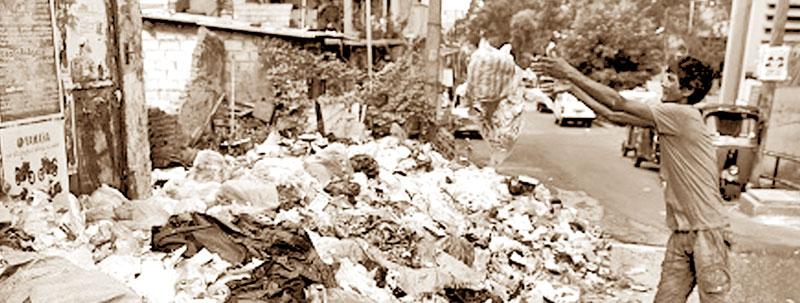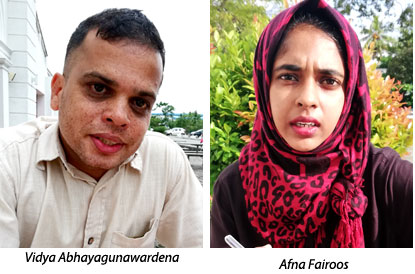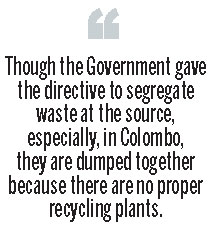
The standoff between Colombo Municipal Council (CMC) and Sri Lanka Land Reclamation and Development Corporation (SLLRDC) came to an end when the former agreed to make an advance payment of Rs. 100 million to the latter to resume the collection of garbage piling up in Colombo.
 The decision, not without dramatisation, came mid this week, as Colombo, which, Megapolis and Western Development Minister Patali Champika Ranawaka vowed to transform into the cleanest city in the region within half a decade, early this year, turned into an eye-sore, with garbage rotting on road sides and causing floods, as they clogged drains during the heavy downpour. The issue ignited when the SLLRDC temporarily discontinued garbage collection due to an outstanding payment of Rs. 207 million due from the CMC.
The decision, not without dramatisation, came mid this week, as Colombo, which, Megapolis and Western Development Minister Patali Champika Ranawaka vowed to transform into the cleanest city in the region within half a decade, early this year, turned into an eye-sore, with garbage rotting on road sides and causing floods, as they clogged drains during the heavy downpour. The issue ignited when the SLLRDC temporarily discontinued garbage collection due to an outstanding payment of Rs. 207 million due from the CMC.
 SLLRDC took over the project to take garbage from Colombo to the Kerawalapitiya Disposal Center where waste is allegedly segregated and sold to traders, and solid waste composted, after the dumping site in Meethotamulla collapsed killing 32 in April 2017. Before Meethotamulla, garbage was collected and dumped in Bloemendhal till 2009. Environmentalists say, the two dumping sites still occasionally witness explosions caused by methane, a greenhouse gas, produced by rotting organic waste.
SLLRDC took over the project to take garbage from Colombo to the Kerawalapitiya Disposal Center where waste is allegedly segregated and sold to traders, and solid waste composted, after the dumping site in Meethotamulla collapsed killing 32 in April 2017. Before Meethotamulla, garbage was collected and dumped in Bloemendhal till 2009. Environmentalists say, the two dumping sites still occasionally witness explosions caused by methane, a greenhouse gas, produced by rotting organic waste.
“We do not have an issue now. Everything is back to normal,” Municipal Commissioner, V. K. A. Anura said, upon the recommencement of garbage collection following a two-day pause.
However, according to environmentalist Vidya Abhayagunawardena, who has been studying the issue for the past 15 years, nothing could be further from the truth. He said, Sri Lanka is moving garbage from one dumping site to another without a proper plan or strategy.
“Garbage is not rocket science anymore. We have enough technology to solve this issue. What we do not have is the political will to do so,” Abhayagunawardena said, adding, thus far governments have failed to provide sustainable solutions to the matter.
Statistics by the Central Environment Authority (CEA) shows Sri Lanka generates 7,500 metric tons of waste per day.
The daily waste collection by local authorities amounts to 3,500 metric tons. CMC said, the daily collection in Colombo is 700 metric tons, while the generation ranges from 900-1,200 metric tons.
Of the total amount 62 per cent is biodegradable, 7 per cent paper, 6 per cent polythene and plastic, 6 per cent wood, 2 per cent glass and 17 per cent other. Environmentalists say, only 20-25 per cent of this waste is recycled because Sri Lanka’s recycling process is still at a preliminary level.
Abhayagunawardena says, it is important to start resolving the issue right at home, school or other base, by segregating waste. He added, even though the Government gave the directive to segregate waste at the source, especially, in Colombo, they are dumped together because there are no proper recycling plants.
“There is no commitment to any decision taken by the Government on this matter. The plastic ban is a good example,” he said.
In December last year, Sri Lanka joined other nations to ban single-use plastics as a part of the UN Environment’s CleanSeas campaign. In January, the ban came into effect, but was short-lived as the country struggled to find a replacement for plastic and polythene.
This was a consequence of several attempts by governments to resolve the country’s garbage crisis. In 2008, the CEA initiated a decade long Waste Management Programme dubbed ‘Pilisaru Programme’. The objective was to achieve a waste free Sri Lanka by 2018. Yet, the absence of a ‘unified coherent strategy has led to inconsistent and ineffective practices’ shows the Environmental Foundation Ltd.
The Government’s next step is to move Colombo’s garbage to the US$ 100.5 million landfill at Arruwakkalu in Puttalam. The plan is to transport compressed waste by train from Colombo to Puttalam. An official said, the project was cleared through an Environment Impact Assessment.
However, the move fuelled resistance from residents in the area where the landfill is located. Silent Volunteers, a group protesting against the Arruwakkalu landfill, stated in a letter to the World Bank branch, Sri Lanka, that the project is located within a mile of the Wilpattu National Park, situated on the east of the landfill site at a distance of about 300 m. “The establishment of the proposed landfill site in such close proximity to an important and popular National Park, which is also an International Ramsar Wetland Conservation site seems to be more problematic,” they stressed adding that, “Kala Oya Delta, situated adjacent to the proposed development site is prone to annual flooding from the Rajanganaya Irrigation Reservoir.
“The annual flooding of this river delta also results in a vibrant mangrove ecosystem which serves as an important habitat as well as a nursery for fish. Flooding incidents in this area have increased in the past few years due to changes in rainfall patterns and climate change, exacerbating the risk. The Kala Oya Delta mangroves serve as breeding ground for fish and therefore, support artisanal and traditional fishing communities from Kalpitiya to Mannar.
The leaching of waste during the wet or monsoon months into this river delta would be detrimental to the mangrove habitat,” the Environmental Foundation officials pointed out.
“We will not be against this project if it is properly planned. But, it is not,” says Afna Fairoos who is also part of the resistance and a resident of Puttalam. She said, the project not only harms the people living in the area but also the animals, especially, the elephants.
“Our people are already going through a lot. We can’t let this happen,” she said.
A 100-day Silent Volunteers-led protest against the landfill is underway in Colombo Face in Puttalam, and today marks its 16th day.
Environmentalist and Environmental Conservation Trust Director Sajeewa Chamikara, pointing out the negative effects of the soon-to-be launched project said, it will not be successful as there needs to be a proper mechanism to segregate garbage.
“We can’t even segregate the organic waste. There is a process to do it because heavy metals in waste can cause severe issues when reacted together,” he said, adding that this would leave composting a failure and organic agriculture that use this compost, a failure too.
He said, with the inception of the Colombo Port City the garbage crisis will multiply.
The future is not so grim if it is managed well. Isolated initiatives by private companies is lending a helping hand to solve the crisis. Several plastic and glass recycle plants mushroomed over the years.
The founder of Earth Bound Creations Pvt Ltd, Uda Peradeniya, Sagara Liyanage said, they use eight tonnes of used newspapers and other paper material per month to create upcycled products such as ornaments and toys. Sometimes, paper has to be bought from Colombo as material collected in Kandy is not sufficient.
“We have also created employment for 600 women in the community. Waste is not waste. It is a treasure. I bring millions to this country by transforming waste into products and exporting them,” Liyanage said
Environmentalist Abhayagunawardena, says, a key step the Government can take to resolve this issue is by setting-up an independent Environment Commission so that stern action can be taken against perpetrators who cause pollution, and also to implement laws such as the plastic ban more thoroughly.
He said, Sri Lanka has to also invest in a good recycling plant with incinerator, stressing the importance of segregation of garbage.
“Garbage is not a problem to the world anymore, but in Sri Lanka it has become a headache, which should not be so, as simple but strategic solutions can fix the crisis.” Abhayagunawardena said.
